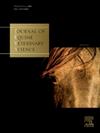Genetic relationship between Neck and Limb defects in Pura Raza Española Horses
IF 1.6
3区 农林科学
Q2 VETERINARY SCIENCES
引用次数: 0
Abstract
Background
Neck and limb conformational defects can impair functionality and performance in Pura Raza Española (PRE) horses. However, their potential genetic relationship has not been previously explored.
Aims/Objectives
To estimate the genetic correlations between two types of neck defects (Cresty neck -CN-, Ewe neck -EN-) and twelve conformational limb defects: Forelimb (Buck knee -BUK-, Calf knee -CK-, Bench knee -BEK-, Knock knee -KK-, Splay-footed forelimb -SFF-, Pigeon-toed forelimb -PTF-), rear limb (Closed hock -CH-, Open hock -OH-, Convergent hock -CVH-, Divergent hock -DVH-, Splay-footed rear limb -SFR-, Pigeon-toed rear limb -PTR-). We hypothesized that a genetic relationship exists between neck and limb morphology.
Methods
This study analyzed 56,644 PRE horses evaluated between 2012 and 2023. Neck and limb conformation traits were scored using two approaches: A) two-class scale (0-no defect, 1-presence of defect); B) three-class scale for limb defects (0-no defect, 1-slight defect, 2-serious defect) and four-class scale for neck defects (0-no defect, 1-slight defect, 2-serious defect, 3-disqualifying defect). Genetic parameters were estimated, including age as a covariate, and sex, genetic origin, management of breeder's stud farm and inbreeding as fixed effects.
Results
The most frequent limb defect among horses with neck defects was SFR (80.15 % in CN and 72.45 % in EN). Genetic correlations showed moderate relationships, ranging from -0.22(s.d.: 0.090) for EN-SFR to 0.44(s.d.: 0.123) for CN-DVH in approach A, and oscillating from -0.25(s.d.: 0.028) for CN![]() CVH to 0.51(s.d.: 0.228) for CN-SFF in approach B.
CVH to 0.51(s.d.: 0.228) for CN-SFF in approach B.
Conclusion
Results support the need for integrated selection strategies targeting both anatomical regions.
Pura Raza马颈部和肢体缺陷的遗传关系Española马
颈部和肢体构象缺陷会损害普拉拉扎Española (PRE)马的功能和表现。然而,它们之间潜在的遗传关系之前还没有被探索过。目的/目的评估两类颈部缺陷(凤头颈- cn -、母羊颈- en -)与12种构象肢体缺陷的遗传相关性:前肢(公膝- buk -、小腿膝- ck -、Bench膝- bek -、Knock膝- kk -、八字足前肢- sff -、鸽趾前肢- ptf -)、后肢(闭式飞节- ch -、开式飞节- - o -、收敛式飞节- cvh -、发散式飞节- dvh -、八字足后肢- sfr -、鸽趾后肢- ptr -)。我们假设颈部和肢体形态之间存在遗传关系。方法本研究分析了2012 - 2023年间评估的56644匹PRE马。采用两种方法对颈部和肢体形态特征进行评分:A)两级量表(0-无缺陷,1-存在缺陷);B)肢体缺陷分为三级(0-无缺陷、1-轻微缺陷、2-严重缺陷),颈部缺陷分为四级(0-无缺陷、1-轻微缺陷、2-严重缺陷、3-不合格缺陷)。估计遗传参数,包括年龄作为协变量,性别,遗传来源,育种者的种马场管理和近交作为固定影响。结果颈部缺损马匹中肢体缺损发生率最高的是SFR (CN为80.15%,EN为72.45%)。遗传相关性为-0.22(s.d。: 0.090), EN-SFR为0.44(s.d。: 0.123),从-0.25(s.d)开始振荡。: 0.028), CNCVH为0.51(s.d。结果表明,需要针对两个解剖区域的综合选择策略。
本文章由计算机程序翻译,如有差异,请以英文原文为准。
求助全文
约1分钟内获得全文
求助全文
来源期刊

Journal of Equine Veterinary Science
农林科学-兽医学
CiteScore
2.70
自引率
7.70%
发文量
249
审稿时长
77 days
期刊介绍:
Journal of Equine Veterinary Science (JEVS) is an international publication designed for the practicing equine veterinarian, equine researcher, and other equine health care specialist. Published monthly, each issue of JEVS includes original research, reviews, case reports, short communications, and clinical techniques from leaders in the equine veterinary field, covering such topics as laminitis, reproduction, infectious disease, parasitology, behavior, podology, internal medicine, surgery and nutrition.
 求助内容:
求助内容: 应助结果提醒方式:
应助结果提醒方式:


